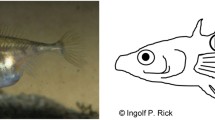Abstract
The scarab beetle, Anomala corpulenta Motschulsky, is a metallic iridescent species that selectively reflects left-circularly polarized light and possesses a brilliant metallic green appearance. We hypothesized that A. corpulenta use the green circularly polarized signal for conspecific communication, specifically sexual signaling and mate selection. To test this, we examined the influence of vision, body color and polarized light environment on the mating behavior of A. corpulenta. The results reported here demonstrate that A. corpulenta uses the green cuticle-reflected light for mate choice in its visual environment, although the role of color and circular polarization separately and independent of each other could not be revealed in this study.





Similar content being viewed by others
References
Blahó M, Egri Á, Hegedüs R, Jósvai J, Tóth M, Kertész K, Biró LP, Kriska G, Horváth G (2012) No evidence for behavioral responses to circularly polarized light in four scarab beetle species with circularly polarizing exocuticle. Physiol Behav 105:1067–1075
Brady P, Cummings M (2010) Differential response to circularly polarized light by the jewel scarab beetle Chrysina gloriosa. Am Nat 175:614–620
Briscoe AD, Chittka L (2001) The evolution of color vision in insects. Ann Rev Entomol 46:471–510
Chapman RF (1998) The insects: structure and function, 4th edn. Cambridge University Press, Cambridge
Chiou TH, Kleinlogel S, Cronin T, Caldwell R, Loeffler B, Siddiqi A, Goldizen A, Marshall J (2008) Circular polarization vision in a stomatopod crustacean. Curr Biol 18:429–434
Egelhaaf M, Kern R (2002) Vision in flying insect. Curr Opin Neurobiol 12:699–706
Goldstein DH (2006) Polarization properties of Scarabaeidae. Appl Opt 45:7944–7950
Hegedüs R, Szél G, Horváth G (2006a) Imaging polarimetry of the circularly polarizing cuticle of scarab beetles (Coleoptera: Rutelidae, Cetoniidae). Vis Res 46:2786–2797
Hegedüs R, Horváth Á, Horváth G (2006b) Why do duskactive cockchafers detect polarization in the green? The polarization vision in Melolontha melolontha is tuned to the high polarized intensity of down welling light under canopies during sunset. J Theor Biol 238:230–244
Horváth G, Varjú D (2004) Polarized Light in Animal Vision - Polarization Patterns in Nature. Springer, Heidelberg
Horvath G, Blaho M, Egri A, Hegedus R, Szel G (2014) Chapter 6. Circular polarization vision of scarab beetles. pp. 147–170 (doi: 10.1007/978-3-642-54718-8_6) In: G. Horvath (editor) (2014) Polarized Light and Polarization Vision in Animal Sciences (2nd edition) Springer Series in Vision Research, volume 2 (series editors: S. P. Collin, J. N. Marshall) Springer: Heidelberg, Berlin, New York
Jewell SA, Vukusic SA, Roberts NW (2007) Circularly polarized color reflection from helicoidal structures in the beetle Plusiotis boucardi. New J Phys 9:99
Lerner A, Meltser N, Sapir N, Erlick C, Shashar N, Broza M (2008) Reflected polarization guides chironomid females to oviposition sites. J Exp Biol 211:3536–3543
Li WZ, Yuan YH, Yuan GH, Luo MH, Guo XR (2009) Selection and feeding responses of Anomala corpulenta adults to different plant leaves. Chin J Ecol 28:1905–1908
Lowrey S, de Silva L, Hodgkinson I, Leader J (2007) Observation and modeling of polarized light from scarab beetles. J Opt Soc Am A 24:2418–2425
Marshall J, Cronin TW, Shashar N, Land M (1999) Behavioural evidence for polarization vision in stomatopods reveals a potential channel for communication. Curr Biol 9:755–758
Menzel R, Backhaus W (1991) Colour vision in insects. In: Gouras HP (ed) Vision and visual dysfunction: the perception of colour. Macmillan Press, London, pp 262–293
Michelson AA (1911) On metallic colouring of birds and insects. Philos Mag 21:554–567
Neville AC, Caveney S (1969) Scarabaeid beetle exocuticle as an optical analogue of cholesteric liquid crystals. Biol Rev 44:531–562
Peitsch D, Fietz A, Hertel H, de Souza J, Fix Ventura D, Menzel R (1992) The spectral input systems of hymenopteran insects and their receptor-based colour vision. J Comp Physiol A 170:23–40
Sharma V, Crne M, Park JO, Srinivasarao M (2009) Structural origin of circularly polarized iridescence in jeweled beetles. Science 325:449–451
Shashar N, Rutledge PS, Cronin TW (1996) Polarization vision in cuttlefish: a concealed communication channel? J Exp Biol 199:2077–2084
Shurcliff WA (1955) Haidinger’s brushes and circularly polarized light. J Opt Soc Am 45:399–410
Acknowledgments
We thank Mr Sheng-jie Ke and Ms Ya-nan Hao and Xiao-ling Zhi for collection assistance. Special Fund for Agro-scientific Research in Public Interest (Project no. 201003025) and the China Agricultural Research System (CARS-03) funded this research.
Author information
Authors and Affiliations
Corresponding author
Rights and permissions
About this article
Cite this article
Miao, J., Wu, YQ., Li, KB. et al. Evidence for Visually Mediated Copulation Frequency in the Scarab Beetle Anomala corpulenta . J Insect Behav 28, 175–182 (2015). https://doi.org/10.1007/s10905-015-9487-3
Revised:
Accepted:
Published:
Issue Date:
DOI: https://doi.org/10.1007/s10905-015-9487-3




